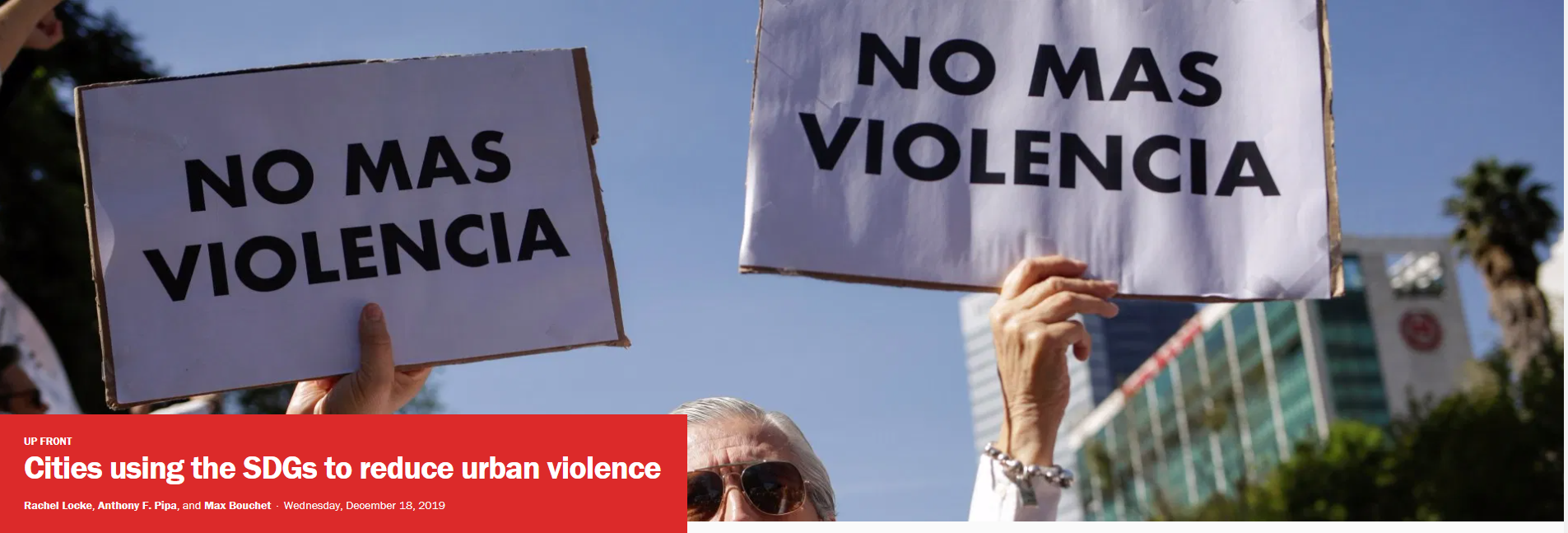Rachel Locke, Anthony F. Pipa, and Max Bouchet
Despite growing prosperity as a leading urban center in Latin America, Mexico City is confronting “a crisis situation in … terms of violence,” according to its Attorney General. Mexico City’s Head of Government Claudia Sheinbaum has made safety a top priority, leading an all-hands-on-deck meeting on security every day, seven days a week. An integrated strategy to address the root causes of violence is underway, investing in both improved policing and reductions in long entrenched inequality and lack of opportunity for young people. This balanced approach recognizes the importance of addressing multiple intersections of inequality in successfully reducing violence, and is reinforced by the city’s endorsement of global agendas such as the Sustainable Development Goals (SDGs).
Urban violence is an issue not just for large municipalities such as Mexico City. Globally, 44 percent of residents of small cities face epidemic levels of violence. Perhaps contrary to popular opinion, these cities are not confined to conflict areas; rather the vast majority of lethal violence takes place in areas ostensibly at peace. In the United States, Violence impedes sustainable development. It undermines health, economic prosperity, access to education, and our broader aspirations for humanity. Its impact on community well-being becomes especially concrete at the local level, where it stresses social cohesion and resilience and reduces new business growth and local job opportunities.
SDG target 16.1 sets a global ambition to significantly reduce all forms of violence and related deaths by 2030 and recognizes the centrality of peace to development. For this target, leadership at the city level is particularly relevant because of what we know about how violence concentrates. In Latin America, 80 percent of homicides concentrate around just 2 percent of street addresses. In the United States, less than 1 percent of a city’s population is typically driving over 50 percent of its serious violence.
While overarching public safety policies are necessary at the national level, the operationalization of law enforcement, community engagement, reduced inequality in the provision of public services, and nuanced analysis of violence trends can and should be taking place within cities. In order to be done effectively, it is crucial to advance and localize the range of evidence-informed practice on what works to address urban violence.
A localized SDG framework can provide useful insights along several lines:
INTERSECTIONALITY
Violence takes different forms. Understanding it requires appreciating the different motivations that contribute to its perpetuation. Too often policymakers think in silos—terrorism, war, domestic violence, child abuse, gang violence, organized crime–rather than appreciating the structural, behavioral, and facilitating factors that contribute to making violence, in its various manifestations, more or less likely.
The integrated nature of the SDGs provides a basis for city leaders to analyze and confront the multifaceted nature of violence head-on. Reinforcing violence prevention and enabling peaceful cities in the long term requires integrating and balancing a range of investments—from increasing gender equality (SDG 5), because more peaceful societies are more gender equal societies, and growing educational (SDG 4) and economic opportunities (SDG 8), to creating safe public spaces (SDG 11) and addressing discrimination (SDG 10). Single entry responses won’t get us far enough.
Best practice in reducing violence urges balanced approaches that activate not only law enforcement capacity, but also the capacities of broader investments in social services, education, improved job opportunities, trauma and behavior therapy responses, and urban renewal investments. These more individually- and community-driven investments are best crafted at the city level. EThekwini Municipality (Durban) is emphasizing a combination of violence prevention, community outreach, and law enforcement in its Safer Cities strategy. In February 2019, Durban started a city-wide community safety audit to identify needs and measure safety perception in various communities.
Applying these capacities in a coordinated way can help ensure the fair deployment of law enforcement that responds to community needs and priorities rather than state-defined parameters. Such responses—if done right—can build legitimacy between governments and the people they are meant to serve. This in turn increases cooperation and can lower impunity rates, an essential component of increasing overall safety.
This is just the kind of work in which Mexico City is investing, combining improved law enforcement with programs to address the root causes of violence. Large investments and dedicated efforts are expanding access to education, sports, decent jobs, cultural activities, and social infrastructure in historically marginalized neighborhoods especially prone to youth violence. In 2019, 150 community centers—part of an initiative called PILARES—offer academic support, economic autonomy, and cultural engagement, with a target of expanding to 300 by 2020. These expanded opportunities for young people complement efforts to address high levels of impunity, fight corruption, invest in community policing,
DATA AND MEASUREMENT
Collecting, reviewing, and constantly analyzing data is key to disrupting negative patterns. Knowing the who, what, when, where, and how helps build strong cases, understand the dynamics of violence, and develop prevention and intervention responses. While for high profile criminal cases this type of data typically is gathered at the national level, often the lower profile, but perhaps more insidious, day-to-day incidents of violence receive far less attention. The lack of investigative or judicial follow-through can result in exceptionally high impunity rates (in the range of 80-90 percent) and pervasive and chronic violence that reinforce negative cycles of trauma and abuse.
The SDGs ask countries to report on the broad ambition of violence reduction, requiring aggregate level data on homicide rates, for example. These ambitions set a “north star,” the guiding point toward which policymakers can organize efforts. But measuring overall homicide levels will do little to practically lower levels of violence. Rather it is diagnosis using incident-level trends that facilitates prevention approaches that proactively address violence.
In Cali, Colombia, the homicide rate increased from 23/100,000 in 1983 to 104/100,000 a decade later. To address this spike, the mayor brought together analytic capabilities from the police, judiciary, forensic, health, and human rights representatives under the direction of an epidemiologist to better understand and prevent the transmission of violence. A few hours away, Bogota has connected sexual assault reports to mapping technology to spatially target police activity. The use of satellite imagery and mobile technology, like the Safetipin app, has also made data collection timelier and more precise. These types of specific, incident-driven data analytics help cities achieve better diagnostics concerning the presence of violence, which in turn helps to design more effective response and prevention efforts.
Public safety and other city officials need to use new models of engagement, knowledge, and analysis to identify and intervene with the people and places most actively involved in violence.
Pittsburgh is disaggregating its data on domestic violence, homicides, and property crime, and seeking to strengthen trust between its communities and the criminal justice system by changing the way police interact with the public, reducing implicit bias, and developing interventions sensitive to racial dynamics. But intervening with those involved in violence goes beyond law enforcement as has been demonstrated by Cure Violence and others actively engaged in outreach, mentoring, behavioral therapy, and more.
MAXIMIZING CITY LEADERSHIP
The experience of cities is varied, and there are a range of networks fostering city-to-city engagement to promote learning and exchange. The Global Parliament of Mayors just included a commitment to reduce violence levels by 50 percent by 2030 in its Durban resolution, with plans for its implementation still under development. The Africa Forum on Urban Safety and European Forum on Urban Safety are examples of regional platforms offering expertise and knowledge diffusion on building safe cities.
Part of a growing movement, cities around the world are strengthening their efforts to advance sustainable development by publishing Voluntary Local Reviews (VLRs) that measure their progress on the SDGs, including SDG 16. The spread of VLRs as a common language creates opportunities for novel peer-learning opportunities.
And with target 16.1 as the inspiration, mayors from 12 cities around the world have joined the Peace in Our Cities campaign to call attention to the scope of violence in cities and the promise of evidence-informed investments to save and protect lives. The 12 early-adopter cities signed on to date are focusing on the most urgent violence priorities within the context of the SDGs. For many, this means reducing lethal violence; for others, it means addressing violence against women or trafficking in persons. As a collective action campaign, Peace in Our Cities will raise awareness of just how significantly violence in urban areas is harming human potential, while simultaneously heralding a call to action given the range of knowledge on successful approaches to lowering violence.
Just as the desire to live free from fear is a universal goal, the need to reduce violence is a universal imperative—one that all cities, no matter their state of development, share.
This article was informed by discussions at the Fall 2019 meeting of the Brookings SDG Leadership Cities Network, hosted by Mexico City.
Read the original article here:https://www.brookings.edu/blog/up-front/2019/12/18/cities-using-the-sdgs-to-reduce-urban-violence/

